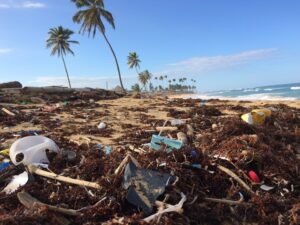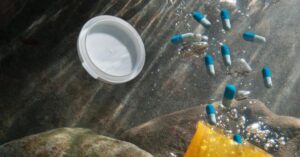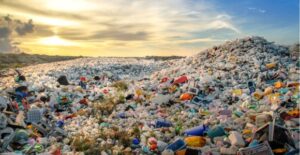Venturing into the complex world of the environmental impact, this article sheds light on a less-talked-about villain: pharmaceutical pollution. Often overlooked, the effects of pharmaceutical pollution in the environment, especially on water sources and wildlife, are both profound and worrisome.
From the pharmaceutical water pollution haunting rivers across the globe to unseen threats looming over various species, we dive into the dynamics of how residues from the pharmaceutical industry contaminate our planet. Join us as we explore pharmaceutical pollution effects on amphibians, impacts on wildlife, and what it means for the world's rivers and, ultimately, for us.
Understanding Pharmaceutical Pollution in the Environment
 When we talk about pollution, images of smoggy cities and plastic-ridden oceans might spring to mind. However, lurking beneath the surface is a more insidious invader: pharmaceutical pollution. This term refers to the presence of medication residues in the environment, which escape through various channels, such as improper disposal of medicine, agricultural runoff, and untreated wastewater.
When we talk about pollution, images of smoggy cities and plastic-ridden oceans might spring to mind. However, lurking beneath the surface is a more insidious invader: pharmaceutical pollution. This term refers to the presence of medication residues in the environment, which escape through various channels, such as improper disposal of medicine, agricultural runoff, and untreated wastewater.
Unlike traditional pollutants, pharmaceuticals are designed to act on biological systems, which means even in small quantities, they can have significant impacts on non-target species and ecosystems.
Despite the critical role medications play in health care, their life-cycle from production to disposal contributes to a less visible but equally concerning form of contamination. As awareness grows, unpacking the effects of pharmaceutical pollution in the environment becomes crucial for paving the path toward sustainable solutions and safeguarding our planet’s health.
The Alarming State of Pharmaceutical Pollution in Water
The purity of the world’s waters is under siege, not just from plastics and industrial waste but also by an invisible threat: pharmaceutical pollution in water.
This toxic brew finds its way into rivers, lakes, and even our drinking water, primarily through human activity and inadequate waste management. Every pill flushed down the toilet, every untreated hospital effluent, contributes to pharmaceutical water pollution. What makes this form of pollution particularly insidious is its invisible nature and its ability to disrupt aquatic ecosystems.
Pharmaceuticals, including everything from antibiotics to hormones, can affect the reproductive systems of aquatic life, leading to long-term ecological imbalances. Acknowledging the gravity of pharmaceutical pollution in water is the first step towards advocating for stronger regulations and encouraging more responsible disposal habits among citizens. Only by shining a spotlight on this issue can we hope to protect our precious water resources for future generations.
Tracing the Roots: Water Pollution from the Pharmaceutical Industry
The path that leads to water pollution from the pharmaceutical industry is convoluted and often overlooked in discussions on environmental preservation.

- Yet, dissecting this journey reveals how manufacturing processes, flawed disposal methods, and regulatory loopholes contribute to the pollution burdening our waterways.
- The pollution from the pharmaceutical industry finds its conduit through direct discharge of contaminants into water bodies, leaching from landfills, and runoff from agricultural land where medicated livestock reside.
Such practices introduce a cocktail of active pharmaceutical ingredients into aquatic environments, setting the stage for adverse effects on both wildlife and human health. Recognizing the roots of this problem underscores the urgent need for a collaborative effort between governments, industries, and communities to adopt sustainable production and waste management practices. Additionally, tightening regulations and implementing advanced treatment technologies could significantly mitigate these toxic flows into our water systems.
Global Insights: Pharmaceutical Pollution of the World's Rivers
The issue of pharmaceutical pollution is not confined to any single region; it is a global crisis that has tainted the world's rivers from the Ganges to the Mississippi.
Studies and reports have painted a worrying picture of how widespread pharmaceutical pollution of the world's rivers has become, marking it as a universal threat to biodiversity, water quality, and public health. These contaminations originate from a variety of sources including human waste, industrial discharge, and runoff, spreading active pharmaceutical ingredients across continents. Notably, antibiotics, painkillers, and hormones are among the most commonly detected compounds.
The widespread presence of these pollutants not only highlights the interconnectedness of our water systems but also calls for an international response to tackle the issue. Addressing pharmaceutical pollution requires global cooperation to implement stricter regulations, improve wastewater treatment infrastructures, and encourage responsible consumption and disposal practices worldwide.
Ripple Effects: Pharmaceutical Pollution Impacts on Wildlife and Amphibians
The ripple effects of pharmaceutical pollution extend far beyond water quality, critically impacting wildlife and, specifically, amphibians.
 These creatures, often hailed as environmental sentinels, are exceptionally vulnerable to the subtle yet pervasive threat of pharmaceutical residues in their habitats. Effects on amphibians include disrupted reproductive patterns, altered behavior, and increased susceptibility to diseases, which in turn affect biodiversity and ecosystem stability.
These creatures, often hailed as environmental sentinels, are exceptionally vulnerable to the subtle yet pervasive threat of pharmaceutical residues in their habitats. Effects on amphibians include disrupted reproductive patterns, altered behavior, and increased susceptibility to diseases, which in turn affect biodiversity and ecosystem stability.
The pharmaceutical pollution impacts on wildlife follow a similar distressing pattern, with studies linking exposure to certain drugs with compromised health and decreased survival rates among various species.
This disturbing trend not only highlights the dire need for awareness and action regarding environmental contamination but also urges a reconsideration of our relationship with pharmaceuticals. Protecting these creatures and their ecosystems calls for concerted efforts to minimize pharmaceutical runoff, improve waste treatment processes, and foster a culture of sustainability and respect for nature.
The Human Connection: Effects of Pharmaceutical Pollution on Humans
Beyond its environmental toll, pharmaceutical pollution bears implications for human health, underlining a direct connection between the health of our ecosystems and our well-being.
The effects of pharmaceutical pollution on humans manifest through the contamination of drinking water sources and accumulation in the food chain, posing risks of long-term exposure to harmful substances. Traces of prescription drugs in water supplies can lead to antibiotic resistance, endocrine disruption, and other health concerns that challenge current treatment and detection capabilities.
Furthermore, the bioaccumulation of pharmaceuticals in aquatic life consumed by humans raises the stakes, making it imperative to address this issue proactively. Encouraging responsible medication disposal, supporting pharmaceutical take-back programs, and advocating for improved wastewater treatment are practical steps each person can take. Ultimately, safeguarding human health demands a commitment to resolving the root causes of pharmaceutical pollution, emphasizing the interconnectedness of our actions and the environment.
